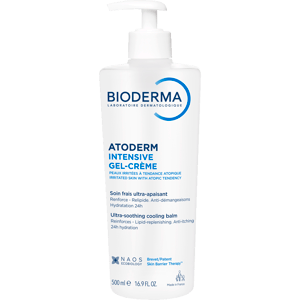Atoderm Intensive gel-crème
BIODERMA

Atoderm Intensive gel-crème
BIODERMA
ATODERM INTENSIVE GEL-CREME
Soin Corps, Visage et corps
BIODERMA

BIODERMA
ATODERM INTENSIVE GEL-CREME
Soin Corps, Visage et corps
Chacun de nos ingrédients ont été sélectionnés pour leur efficacité. Retrouvez tous les ingrédients de votre produit regroupés dans des familles en fonction de leur rôle.
Brevet Skin Barrier Therapy
Hydratant
Relipidant
Apaisant
Eau de formulation
Texture
Protection du produit
Les ingrédients de nos formules ont été sélectionnés selon des critères dermatologiques très stricts et recommandés par des experts toxicologues indépendants. Classés dans trois grandes catégories d’actifs, vous découvrirez la nature, le rôle et l'origine de chacun en cliquant sur leur nom.
Ici sont regroupés les ingrédients qui contribuent à l'efficacité attendue du produit : ceux qui optimisent ou préservent les mécanismes biologiques de la peau (comme l'hydratation, la régénération, l’action relipidante), et ceux qui possèdent une action physico-chimique bien spécifique (exfoliant, matifiant, filtres solaires...).
Les ingrédients listés ici sont ceux contenus dans la dernière formule de ce produit. Un décalage de temps pouvant exister entre sa production et sa diffusion sur le marché, nous vous invitons à consulter la liste des ingrédients figurant sur l’emballage

Pour quel type de peau ce produit est-il fait ? Comment appliquer Atoderm Intensive gel-crème ? Quand l'utiliser ? Quels sont les formats disponibles ?

Notre démarche de transparence
Bienvenue dans nos Laboratoires à Aix-en-Provence.
Découvrez notre approche scientifique unique, l’écobiologie.